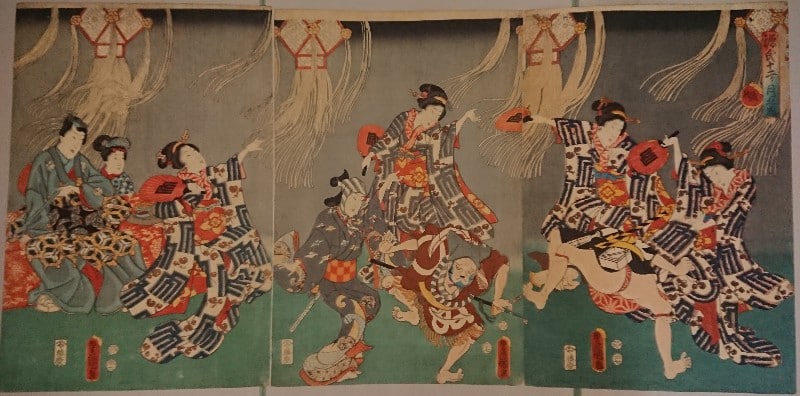
Introduction
Bon Odori has a history of 500 years and is still a representative folk art of Japan enjoyed by many people today. However, there are still many mysteries about its history.
Bon dance is something that our ancestors memorized and passed down through their “bodies” (eyes, ears, mouth, gestures, etc.) without relying on written texts. In this respect, it is similar to “folktales”. In addition, since Bon Odori dance was basically a folk custom, the records kept by the ruling class and the elite are fragmentary.
For this reason, reconstruction from written records is limited.
On the other hand, some of the Bon Odori dances handed down in various regions still retain the appearance of the old days, giving us a chance to imagine what it was like in the past. However, these old dances are small in numbers, and they are always in danger of reducing, disappearing, or being transformed.
Thus, there are not many clues to explore the history of Bon Dancing. However, this also means that there is still a lot of room to infer and enjoy the history of Bon Dancing. Let us try to imagine the history of Bon Dancing through the few literary materials and the study of old examples that remain in various places.
Overview of the History of Bon Dancing
It is a mistake to imagine that the appearance, circumstances, and timing of changes in Bon Dancing were the same throughout the country. This is because the origin, speed of change, and content of traditional performing arts, not limited to Bon Dancing, differ from region to region. This is the difficult part in depicting the history of traditional performing arts.
However, it is possible, to some extent, to extract the religious and entertainment characteristics common to each period and to follow the process of change in Bon Dancing. Here is a rough summary of the characteristic Bon dances of each period and their changes over time.
0-1 The History of Uraabon
The History of Uraabon Sutra The Urabon Sutra, the basis of Obon, is believed to be a sut...
Read more0-2 Ancient Japanese customs of the common people (not documented)
What is folklore studies all about? In historical science, we read history through litera...
Read more0-3 Late Heian Period, just before the birth of Bon Dancing
Occurrence of Furyu Furyu" became a central element of the popular arts throughout t...
Read more1.Kamakura Period Birth of Dancing Nembutsu
Overview In the late Kamakura period, among the New Buddhims, Ippen Shonin’s Odori Nembut...
Read more2.Birth of Bon no Furyu Odori (Bon Dance) in the mid-Muromachi Period
Overview As times moved from the unification of the Northern and Southern Dynasties to th...
Read more3.Late Muromachi - Sengoku - Azuchi-Momoyama Rise of Fuuryu Odori and Regional Expansion
Overview As times moved from the unification of the Northern and Southern Dynasties to th...
Read more4.Early Edo Period Establishment of Bon Dancing
Overview The "age of dance," which had lasted for about a century, was transfor...
Read more5.Mid to Late Edo Period Bon Dancing takes root and matures
Overview Culture develops as the economy grows and the society becomes stable. Under a ce...
Read more6.Meiji: A Turning Point for Bon Dancing
Overview From Edo to Meiji After the Meiji Restoration, the policy of westernization led...
Read more7.Taisho Era - Early Showa Era Revival of Bon Dancing
Overview Japanese Cultural Revival of the Taisho Era The Taisho period was a time of red...
Read more8.Before and After the War Wartime Response, Suspension and Resumption
Overview Around 1937, when the Sino-Japanese War began, the proportion of wartime and mil...
Read more9.Late mid-Showa period Nationwide expansion of Ondo and Minyo (folk songs)
Overview Peace came after a period of postwar impoverishment and re-independence. Japan e...
Read more10.Heisei Reiwa: From Stagnation to the Birth of a New Axis
Overview As in the late Showa period, the stereotypical image of Bon Odori continued ,as ...
Read more